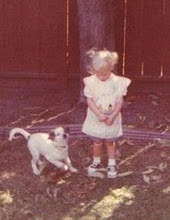
Dirt paths can equal muddy paw tracks on your carpet, so when possible, try to opt for concrete, brick, & stone walkway materials.
If your dog is running his own favorite pathways into your lawn, rather than fight against it, lay down permanent walkways along his preferred trail and landscape around them.
Leave a gap between your fence and flowerbeds for dogs who like to pacerun alongside fencing (this way they'll have enough space and won't trample your plants.)
If you have rambunctious pups, consider creating a puppy play yard within your existing yard. This will keep curious canines out of temperamental flower beds and other special areas you'd prefer be off-limits. Clearly delineate the play area with a fence (if you use lumber, make sure it does not contain preservatives and is not treated with CCA.)
To help guide dogs who love to dig, consider creating a special digging space. You can use wood chips, leaves, mulch or a mix of sand & soil (superdiggers especially like sand!) Encourage your dog to dig in that space by hiding fun little treasure hunt treat-filled toys for them to unearth (and, of course, praise them whenever they dig in their special digging spot.)
Don't let your dog see you weed or plant ... it might sound silly, but many dogs start digging because they see mom and dad doing so and they decide they'd like to "help out" the pack by mimicking the behavior.
If needed, use fabric strips to stake plants rather than invisible wiring (so your dog won't accidentally run into them.)
Plant with your dog in mind, and stay away from delicate species. Some attractive, vigorous plants include: peony, creeping phlox, verbena, coneflower, black-eyed susans, shasta daisy, liriope, russian sage, and mexican primrose. Plants that resist breakage include serviceberry, ninebark, mock orange, dogwood, lilac, pine, butterfly bush and quince. Tough shrubs include escallonia, laurel, peris, evergreen huckleberry and viburnum.
Be aware of poisonous plants, and remove them from your garden (and home, too.) Be sure to use only pet-safe, non-toxic fertilizers and pest repellents.
Try using a thick carpet of pine cones as mulch (it's uncomfy on paws and can discourage pet traffic.)
Consider container gardening. Potted plants are often easier for families with pets to maintain.
Keep an eye on things like loose lava rocks, river stones, etc., and make sure your dog isn't turning them into her own homemade chew toys. If you see this happening, use the "leave it" or "bring it/drop it" command, redirect the behavior, and consider removing (or isolating) these items from your current landscape permanently.
Just like everything else pup-related, you can avoid a lot of frustration by being creative and... by thinking like a dog! By keeping your pet's interests in mind, you can design a garden that brings beauty & harmony to humans and canines alike. For more ideas, and excellent, inspiring photos of lush, dog-friendly landscaping, check out Dog Friendly Gardens, Garden Friendly Dogs by Master Gardener Cheryl Smith.









No comments:
Post a Comment